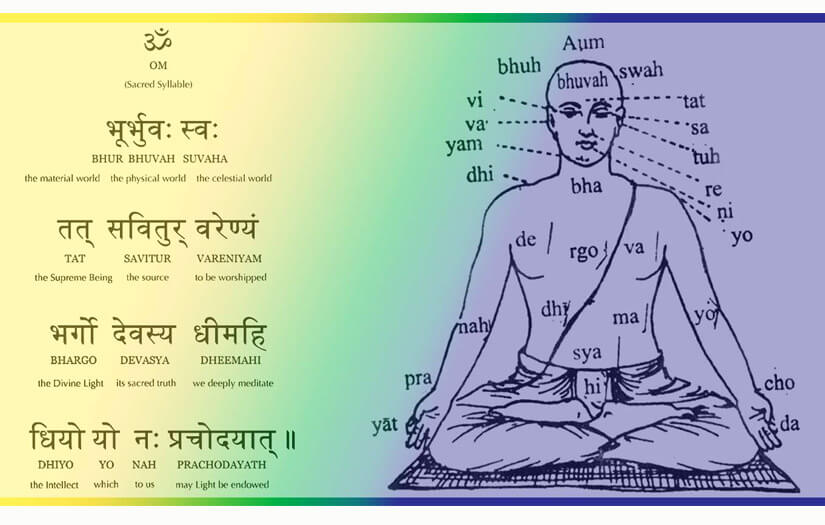The Power of Mantras: The sages tell us that truth, consciousness, and bliss are our inherent essence and that the separation from these aspects of ourselves is the root of all our suffering. The Power of mantras is essential to enlighten us from within. They claim that although the mind is constantly looking for solutions to stop its pain, it typically limits this search to the outside world and only discovers additional agony. And even when we become wise enough to delve inward, all we initially find are jumbled, unmanageable thoughts, sensations, and daydreams.
The sages concur that while meditation is the way to ultimate reality, having a disorganised mind would inevitably lead to delays. They teach us that mantra is the means by which the mind gets inwardly focused and ultimately arrives at the eternal silence that is the foundation of happiness.
Table of Contents
1. The Power of Mantras

The Power of Mantras: A mantra is a word that has been disclosed, a celestial sound that an adept in a deep state of samadhi (spiritual absorption) has heard or received. It is the Divine Being’s sound body, a concentrated form of spiritual energy. It is also comparable to a brief prayer. Mantra is sometimes compared in yogic literature to a boat or a bridge that an aspirant might use to ascend to the inner center of consciousness from the mud of delusion caused by the outside world.
According to mystics and yogis, a mantra is an enduring companion that follows a meditator into the afterlife, illuminating the path in a region beyond the reach of the sun and moon. Mantra is the essence of guru Shakti, the power of the spiritual teacher, according to the more esoteric literature of the yoga tradition. Stated differently, the guru is the mantra itself. A mantra is the same as God, a guru, or one’s highest self.
All creation originates from the Word, according to the school of metaphysics known as spanda, or the science of eternal vibration. The term “word” in this context does not refer to spoken language or the sound made when two items collide. Pure consciousness vibrates endlessly, and the Word is anahata nada, the unstruck sound. It is the Word that predated the start of the universe.
2. Revelation

The Power of Mantras: The boundless wisdom and happiness that emerge from inside are beyond the reach of human language. The common languages of the world are like the mist of early morning; the mantra’s rays are the light that causes this mist to dissipate, revealing the edge of our inner reality. Bathed in this radiance, the seer speaks in a language known to the yogis as sandhyabhasa, the language of twilight. This is the original, global language that predated the language confusion depicted in the Old Testament Tower of Babel story.
The sages continued to communicate with God unhindered, and they did not participate in the construction of the Tower of Babel. However, we have become disconnected from the global language as a result of creating our own tower of ego, attachment, desire, rage, wrath, envy, and greed, which has severely hindered the sages’ ability to impart their wisdom to us.
But to a few, usually at the top of a mountain or in some other remote location, they did succeed in speaking in a mysterious tongue that was neither quite earthly nor entirely spiritual. However, they had to water down their message in order to be understood at all, even if it meant obstructing the full impact of the revelation.
3. Mantra and its Meaning

The Power of Mantras: The Word is indestructible and indivisible because it is the eternal truth. However, there are countless mantric insights into this reality. For instance, there are mantras for siddhis (supernatural abilities) and meditation mantras that encourage spiritual unfoldment in the yoga discipline.
Mantras used for meditation, mostly found in the Upanishads, are tools for contemplation because, in most cases, aspirants who understand the meaning of the mantra they are reciting develop a feeling for it while they are in meditation. Mantras have meanings so small and compact that seekers may have to think about them over and again for a considerable amount of time. As they go, the meaning becomes apparent in a constant wave that illuminates the inner workings of the heart and mind, changing the meditator in the process.
4. The Universal Mantra

The Power of Mantras: The sound of breathing is the inner sound that is easiest to identify. You can hear the sound hum as you exhale and the sound as you inhale if you sit in a calm area and pay attention to its flow. The so-hum easily resonates with each breath we take in and release. However, the sound is not as loud as the breath. It is an axiom for all people. Everyone has it from birth. It is essential to our survival.
The rhythm of life is inherent in our breathing, and by focusing on the sound of our breaths as we take them in and release them, we are attending to the beat of life. These are not euphemistic remarks. You can vouch for these facts based on your personal experience. As soon as the mind is allowed to settle into a state of calm, tension, fear, and anxiety dissolve.
5. How to Meditate with Mantras

The Power of Mantras: To approach meditation methodically, start with developing a steady, comfortable sitting posture, learning to make the breath tranquil, and quieting and balancing the physical body. That is the intention behind the hatha yoga poses and breathing exercises. The next stage is to start practicing breath awareness and removing the mind from outside matters.
Start by observing how the breath moves from the nostril tips to the centre of the heart and back again. Initially, you will notice that this easy exercise brings a sense of peace because it differs greatly from the typical habit of allowing the mind to wander. However, when the surface mental clutter starts to fade, new subtle patterns show up, and the profound sense of serenity that comes with breath awareness wanes.
The Power of Mantras: Wrapping Up
The Power of Mantras: The literature of mantra science and practice, known as mantra shastra, is quite particular concerning the laws and regulations of initiation. It outlines who, what, and when to initiate. It is made very evident that before stepping forward to mentor a student, a teacher must gain a thorough comprehension of these concepts.
Mantra shastra places even greater emphasis on the requirement that instructors receive training from a qualified master who possesses the ability to bless them, guide them from within, and correct them if they start misguiding others. I hope these tips were helpful in teaching you the power of mantras. For more insightful content, stay tuned to Digital Gabbar. You may also like to get your hands on this article: Exploring the Advantages of Having a Pet: A Life-changing Decision








